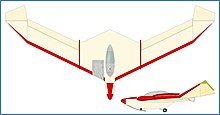MAY-68
The MAI-68 ( Russian МАИ-68 ) was a Soviet experimental glider with a flying wing design.
prehistory
In 1963, under the direction of A. I. Pezuch , students at the Moscow Aviation Institute (MAI) built the experimental glider MAI-63. The special features were the extremely slim outer wing with laminar profile and the large expansion flaps on the wing tips. The wing deepened very strongly towards the central axis. So the pilot could be accommodated completely, and only the teardrop-shaped cabin cover protruded from the profile contour. Unfortunately, the slim all-metal wing with a wingspan of 12 m proved to be insufficiently torsionally rigid, which ultimately led to the flight tests being discontinued. Then another version called MAI-68 was built, which received a deeper outer wing. The head of the project was Vladimir Pushkin.
technology
This machine had upwardly bent wing tips with enlarged flaps. In order to give the pilot a better view of the ground during landing, part of the planking on the right wing was transparent. Ample boundary layer fences were attached at the transition between the wing center section and the outer wing . It was controlled via elevons and the large splay flaps on the wing tips, which, like the Northrop B-2, took over the function of the rudder. Due to the low weight and the name of its designer, the machine was nicknamed "Puschinka".
testing
The flight tests began in July 1970. First, flight tests were carried out near the ground using a glider take-off winch in order to explore the control properties. After it turned out that the effect of the spreading flaps was not sufficient, they were enlarged. After further tests had shown usable controllability, tow plows were dared behind a Jak-12 . The construction now met the expectations. The MAI-68 remained in flight operations until the mid-1970s, u. A. at ZAGI .
Technical specifications
| Parameter | Data |
|---|---|
| span | 10 m |
| length | 5 m |
| Empty mass | 86 kg |
| Takeoff mass | 177 kg |
| Glide ratio | 21st |
literature
- Rudolf Storck among others: Flying Wings. The historical development of the world's tailless and flying wing aircraft. Bernard and Graefe, Bonn 2003, ISBN 3-7637-6242-6 .
Web links
- Pictures on J2mcl-Planeurs
- МАИ-68. Retrieved January 6, 2019 (Russian).

